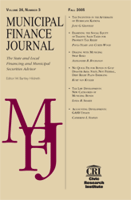Complete Issue
Author: W. Bartley Hildreth.
Source: Volume 37, Number 02, Summer 2016 , pp.1-92(92)

< previous article |return to table of contents
Abstract:
An adequate public infrastructure is an economic and policy issue at all levels of government. Public administration professor Can Chen examines how capital spending on state transportation infrastructure has responded to fiscal stress over two economic recessions. Employing a composite fiscal stress index, he finds that this infrastructure spending has been negatively affected by state fiscal stress. MFJ thanks guest editor public affairs professor Tima Moldogaziev for handling the blind peer review of this paper presented at the public finance and budgeting section of the 2015 Western Social Science Association meeting. The effect of the Great Recession on investor’s risk-averse behavior, and more specifically, the nature of that risk aversion, is important to understand. Public administration professors Kenneth A. Kriz and Qiushi Wang examine the risk premium captured by yield spreads between municipal securities and Treasury securities of a similar maturity. Their time-series study reveals that short-term risk aversion increased but did not persist, while long-term risk aversion increased less dramatically but lasted for a longer period of time. State and local governments increased the nature of their government-wide financial disclosures with the implementation of the 1999 Governmental Accounting Standards Board pronouncement known as Statement No. 34. The market value of these disclosures is determined by users, including, but not limited to, municipal bond analysts. Accounting professor Rebecca Bloch surveys members of the National Federation of Municipal Analysts and finds that they consider the government-wide financial statements to be an improvement and they like the new management discussion and analysis section, but that they still rely on fund financial statements. As the GASB considers revisions to Statement No. 34, this study offers valuable insights. Industrial development bonds are a small but significant segment of the municipal market, with default rates higher than public purpose bonds. Economics professor Diane Coogan-Pushner and graduate student Josh Keller extend the time period of earlier default studies of this segment. They report that the default rate of IDBs has declined but that IDBs continue to pay a large spread to compensate investors for the risks inherent in this market.Keywords: Fiscal stress, infrastructure finance, highways, state governments, composite index, risk premium, financial crisis, yield spread, GASB Statement No. 34, municipal disclosure, industrial development bonds (IDBs)
Affiliations:
1: Georgia State University.